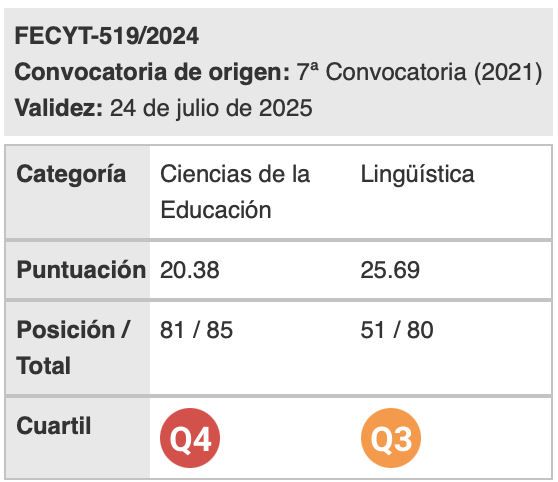Reflections on the Use of Nonverbal communication in teaching Spanish to sino-speakers
Palabras clave:
nonverbal communication, classroom, Spanish, Sino-speaker, immediacyResumen
The increased interest in Spanish as a Foreign Language (FL) has meant that in China alone there are 25,000 university students taking Spanish courses (Instituto Cervantes, 2013). The demand for Spanish language and culture courses has yet to be met by adequate numbers of teachers with a good understanding of Chinese culture, especially if we question the uniformity of that culture over all regions of Sino-speakers (in particular China, Hong Kong and Taiwan). Traditionally Chinese values have been linked to the works of Confucius and are often reflected in nonverbal communication (NVC). In FL teaching the implications of nonverbal communication are often not properly understood, despite their importance to thinking (McNeill and Duncan, 2000), to creating immediacy with students (Mehrabian, 1972), and in ensuring that students of the FL are accepted by native speakers of the language (Neu, 1990). We argue that FL teachers should understand the importance of NVC in the classroom, although it is not usually included in textbooks, and be aware of cultural differences among Sino-speakers, and of how these affect NVC and so communication.
Descargas
Citas
Andersen, J. F., Andersen, P. A., & Jensen, A. D. (1979). The measurement of nonverbal immediacy. Journal of Applied Communication Research, 7, 153-180.
Andersen, J. F., Norton, R. W., & Nussbaum, J. F. (1981). Three investigations exploring relationships between perceived teacher communication behaviors and student learning. Communication Education, 30(4), 377-392.
Aviezer, H., Trope, Y., & Todorov, A. (2012). Body cues, not facial expressions, discriminate between intense positive and negative emotions. Science, 338(6111), 1225-1229.
Burgoon, J. (1980). Nonverbal communication research in the 70s: An overview. In D. Nimmo (Ed.), Communication yearbook 4 (pp. 179-197). New Brunswick, NJ: Transaction Books.
Burgoon, J., Buller, D., & Woodall, W. G. (1994). Nonverbal communication: The unspoken dialogue. Columbus, OH: Greyden Press.
Cheung, G., & Chow, I. (1999). Subcultures in greater China: A comparison of managerial values in the People’s Republic of China, Hong Kong and Taiwan. Asia Pacific Journal of Management, 16, 369-387.
Collins English Dictionary (2009). Retrieved from: http://www.collinsdictionary. com/dictionary/english.
Confucius, & Waley, A. (1938). The analects of Confucius. New York, NY: Random House.
Cortés-Moreno, M. (2004). Análisis acústico de la producción de la entonación española por parte de sinohablantes. Revista de fonética experimental, 8, 79-110.
Darwin, C. (1872/1998). The expression of the emotions in man and animals (3rd ed.). New York, NY: Oxford University Press.
Duncan, S. (2006). Co-expressivity of speech and gesture: manner of motion in Spanish, English, and Chinese. Proceedings of the 27th Berkeley Linguistic Society annual meeting (pp. 353-370). Berkeley, CA: Berkeley University Press.
Duncan, S. Jr. (1972). Some signals and rules for taking speaking turns in conversations. Journal of Personality and Social Psychology, 23(2), 283-292.
Ekman, P., & Friesen, W. V. (1969). The repertoire of nonverbal behavior: categories, origins, usage and coding. Semiotica, 1(1), 49-98.
Erasmus, D. (1530/2003). On good manners. In E. Rummel (Ed.), The Erasmus reader (pp. 101-118). Toronto: University of Toronto Press.
Feyereisen, P. (1997). The competition between gesture and speech production in dual-task paradigms. Journal of Memory and Language, 36, 13-33.
Feyereisen, P., & Lannoy, J. D. (1991). Gestures and speech: psychological investigations. New York, NY: Cambridge University Press.
García-García, M. (2001). El lugar de la comunicación no verbal en la clase de ELE kinésica contrastiva. Doctoral Dissertation. Universidad de Salamanca.
Gardner, H. (1985). The mind’s new science: A history of the cognitive revolution. New York, NY: Basic Books.
Goldin-Meadow, S. (2005). Hearing gesture: How our hands help us think. Boston, MA: Harvard University Press.
Gullberg, M. (2006). Handling discourse: Gestures, reference tracking, and communication strategies in early L2. Language Learning, 56(1), 155-196.
Gullberg, M. (2011). Thinking, speaking, and gesturing about motion in more than one language. In A. Pavlenko (Ed.), Thinking and speaking in two languages (pp. 143-169). Bristol, UK: Multilingual Matters.
Guo, L., & Chen, L. (2009). Learning to express motion in narratives by Mandarin-speaking children. In J. Guo, E. Lieven, N. Budwig, S. Ervin-Tripp, K. Nakamura, and Ş. Özçalişkan (Eds.), Crosslinguistic approaches to the psychology of language (pp. 193-208). New York, NY: Psychology Press.
Hadar, U. (1992). The dissociation between motor and symbolic movements in coverbal behavior. In F. Poyatos (Ed.), Advances in nonverbal communication (pp. 113-124). New York, NY: J. Benjamins Pub. Co.
Hofstede, G. (1991). Cultures and organizations: Software of the mind. Maidenhead, UK: McGraw-Hill.
Hofstede, G., & Minkov, M. (2010). Cultures and organizations: Software of the mind (3rd ed.). New York, NY: McGraw-Hill.
Instituto Cervantes (2013). Anuario. Madrid: Instituto Cervantes. Retrieved from: http://cvc.cervantes.es/lengua/anuario/ anuario_12/.
Instituto Nacional de Estadística (INE) (2012). España en cifras. Madrid, Spain: INE.
Jack, R., Caldara, R., & Schyns, P. (2012). Internal representations reveal cultural diversity in expectations of facial expressions of emotion. Journal of Experimental Psychology: General, 141(1), 19-25.
Kendon, A. (2004). Gesture: Visible action as utterance. New York, NY: Cambridge University Press.
Kita, S. (2000). How representational gestures help speaking. In D. McNeill (Ed.), Language and gesture: Window into thought and action (pp. 162–185). New York, NY: Cambridge University Press.
Knapp, M. (2006). A historical overview of nonverbal research. In V. Manusov, and M. L. Patterson (Eds.), The SAGE handbook of nonverbal communication (pp. 3-20). Thousand Oaks, CA: SAGE Publications, Inc.
Knapp, M., & Hall, J. (2010). Nonverbal communication in human interaction. Boston, MA: Wadsworth, Cengage Learning.
Lei, R. M., & Chen, H. P. (2011). Zhong xi fang ketang wenhua chayi xiaoyi. People’s Education Press. Retrieved from: http://www.pep.com.cn/ge/jszx/jxyj/ jylw/201103/t20110303_1025437.htm.
Li, J. (2009). Learning to self-perfect: Chinese beliefs about learning. In C. Chan, and N. Rao (Eds.), Revisiting the Chinese learner. Changing contexts, changing education (pp. 35-70). Hong Kong. The University of Hong Kong.
Lin, L., & Ho, Y. (2009). Confucian dynamism, culture and ethical changes in Chinese societies – a comparative study of China, Taiwan and Hong Kong. The International Journal of Human Resource Management, 20(11), 2402-2417.
López-Ozieblo, R. (2012). ¿Ahora hablo yo?: Observaciones de cómo negocian los turnos discursivos estudiantes hongkoneses de español. Proceedings of the III Encuentro de Profesores de Español para Sinohablantes (EPES) (pp. 212-220). Jaén, Spain: Publicaciones de la Universidad de Jaén.
McCroskey, J., & McCroskey, L. (2006). Nonverbal communication in instructional contexts. In V. Manusov, and M. L. Patterson (Eds.), The SAGE handbook of nonverbal communication (pp. 421-436). Thousand Oaks, CA: SAGE Publications, Inc.
McCroskey, J., Sallinen, A., Fayer, J., Richmond, V., & Barraclough, R. (1996). Nonverbal immediacy and cognitive learning: A cross-cultural investigation. Communication Education, 45, 200-211.
McNeill, D. (2000). Catchments and contexts: Non-modular factors in speech and gesture production. In D. McNeill (Ed.), Language and gesture: Window into thought and action (pp. 312-328). New York, NY: Cambridge University Press.
McNeill, D. (2009). Imagery for speaking. In J. Guo, E. Lieven, N. Budwig, S. Ervin-Tripp, K. Nakamura, and Ş. Özçalişkan (Eds.), Crosslinguistic approaches to the psychology of language (pp. 517-530). New York, NY: Psychology Press.
McNeill, D. (2012). How language began: Gesture and speech in human evolution. New York, NY: Cambridge University Press.
McNeill, D., & Duncan, S. D. (2000). Growth points in thinking-for-speaking. In D. McNeill (Ed.), Language and gesture: Window into thought and action (pp. 141-161). New York, NY: Cambridge University Press.
Mehrabian, A. (1972). Nonverbal communication. Chicago, IL: Aldine-Atherton. Mehrabian, A. & Ferris, S. (1967). Inference of attitudes from nonverbal communication in two channels. Journal of Consulting Psychology, 31(3), 248-252.
Monterubbianesi, M. G. (2013). La comunicación no verbal en los manuales de E/LE. Revista electrónica de didáctica del español lengua extranjera, 25. Retrieved from: http://www.mecd.gob.es/dctm/redele/Material-RedEle/Revista/2013/ 2013_redELE_25_03Monterubbianesi.pdf?documentId=0901e72b8159e598.
Neu, J. (1990). Assessing the role of nonverbal communication in the acquisition of communicative competence in L2. In Scarcella, R., Andersen E. S., and Krashen S. D. (Eds.), Developing communicative competence in a second language (pp. 121-138). New York, NY: Newbury House Publishers.
Neuliep, J. W. (2003). Intercultural communication: A contextual approach (2nd ed.). New York, NY: Houghton Mifflin.
Poyatos, F. (1992). The audible-visual approach to speech as basic to nonverbal communication research. In F. Poyatos (Ed.), Advances in nonverbal communication, (pp. 3-24). New York, NY: J. Benjamins Pub. Co.
Quintilian (90AD/1920). Institutio oratoria. ( H.E. Butler Trans.). Harvard, MA: Harvard University Press.
Rigal, A. (2012, March 10). Invasión de estudiantes chinos en las facultades de economía españolas. El Confidencial. Retrieved from: http://www. elconfidencial.com/sociedad/ 2012/03/10/invasion-de-estudiantes-chinos- en-las-facultades-de-economia-espanolas-94072/.
Rummel, E. (Ed.). (2003). The Erasmus reader. Toronto, ONT: University of Toronto Press.
Sacks, H., Schegloff, E. & Jefferson, G. (1974). A simplest systematics for the organization of turn-taking for conversation. Language, 50, 696-735.
Schmitt, J. C. (1991). The rationale of gesture in the West: Third to thirteenth centuries. In J. Bremmer, and H. Roodenburg (Eds.), A cultural history of gesture (pp. 59-70). Oxford, UK: Polity Press.
Schneller, R. (1992). Many meanings: Nonverbal diversity in Israel. In F. Poyatos (Ed.), Advances in nonverbal communication (pp. 21-236). New York, NY: J. Benjamins Pub. Co.
Slobin, D. (1996). Two ways to travel: Verbs of motion in English and Spanish. In M. Shibatani, M., and S. A.Thompson (Eds.), Grammatical constructions: Their form and meaning (pp. 195–219). Oxford, UK: Oxford University Press.
So, W. C. (2010). Cross-cultural transfer in gesture frequency in Chinese –English bilinguals. Language and Cognitive Processes, 25(10), 1335-1353.
Talmy, L. (2009). Main verb properties and equipollent framing. In J. Guo, E. Lieven, N. Budwig, S. Ervin-Tripp, K. Nakamura, and Ş. Özçalişkan (Eds.), Crosslinguistic approaches to the psychology of language (pp. 193-208). New York, NY: Psychology Press.
The Chinese Culture Connection (1987). Chinese values and the search for culture-free dimensions of culture. Journal of Cross-Cultural Psychology, 18, 143-164.
Wang, Y. (2008). Teacher’s verbal and nonverbal behavior in college classroom interaction. Master thesis. Hong Kong: Hong Kong Polytechnic University.
Wu, F. M. (2004). Problems faced by Chinese learners in L2 English learning and pedagogic recommendations from an intercultural communication perspective. Retrieved from: http://www3.telus.net/linguisticsissues /problemschinese.html.
Zhang, Q. (2005). Immediacy, humor, power distance, and classroom communication apprehension in Chinese college classrooms. Communication Quarterly,53(1), 109-124.
Zhang, Q. (2006). Immediacy and out-of-class communication: A cross-cultural comparison. International Journal of Intercultural Relations, 30, 33-50.
Zhao, J. (n.d.). The communicative functions of gestures in L2 Speech. Retrieved from: http://w3.coh.arizona.edu/ AWP/AWP13/AWP13%5BZhao%5D. pdf.
Descargas
Publicado
Cómo citar
Número
Sección
Licencia
Aquellos autores/as que tengan publicaciones con esta revista, aceptan los términos siguientes:
- Los autores/as conservarán sus derechos de autor y garantizarán a la revista el derecho de primera publicación de su obra, el cuál estará simultáneamente sujeto a la Licencia de reconocimiento de Creative Commons que permite a terceros compartir la obra siempre que se indique su autor y su primera publicación esta revista.
- Los autores/as podrán adoptar otros acuerdos de licencia no exclusiva de distribución de la versión de la obra publicada (p. ej.: depositarla en un archivo telemático institucional o publicarla en un volumen monográfico) siempre que se indique la publicación inicial en esta revista.
- Se permite y recomienda a los autores/as difundir su obra a través de Internet (p. ej.: en archivos telemáticos institucionales o en su página web) antes y durante el proceso de envío, lo cual puede producir intercambios interesantes y aumentar las citas de la obra publicada. (Véase El efecto del acceso abierto).

Revista de Lenguas para fines específicos is licensed under a Creative Commons Reconocimiento-NoComercial-SinObraDerivada 4.0 Internacional License.






















